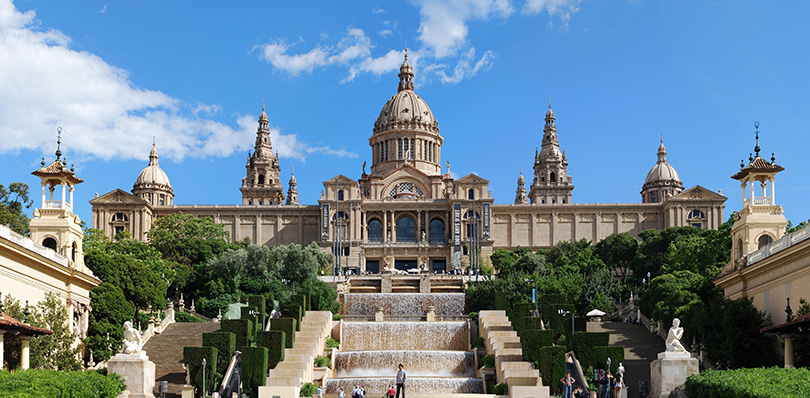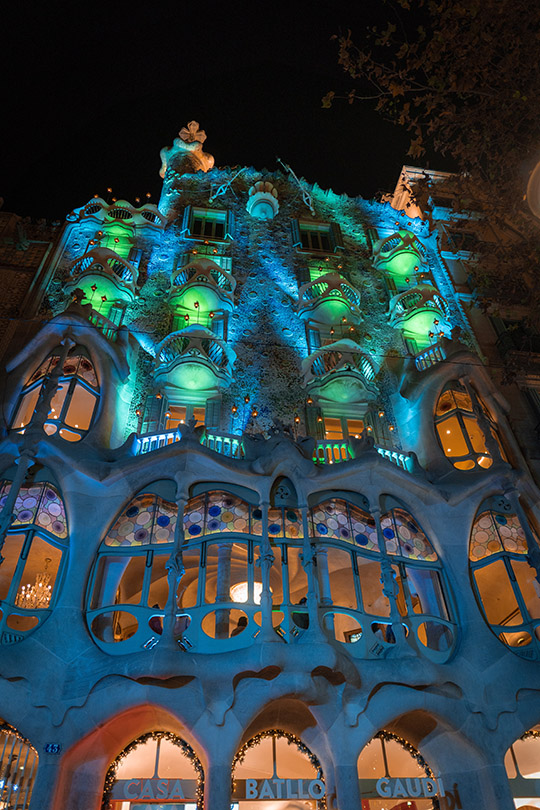
Museum of National Art of Catalonia, Barcelona; credit Felix Konig
Barcelona Museums
Picasso Museum
It houses 4251 artworks by the 20th-century Spanish artist Pablo Picasso. It is housed in five adjoining medieval palaces on Montcada Street in the La Ribera neighborhood in the Old City. It opened to the public in 1963, becoming the first museum dedicated to Picasso’s work and the only one created during his lifetime. It has since been declared a museum of national interest by the Government of Catalonia. Highlights of the collection include two of his first major works, The First Communion, and Science and Charity. In particular, Museu Picasso reveals Picasso’s relationship with the city of Barcelona, a relationship that was shaped in his youth and adolescence and continued until his death. Tue-Sun 10 am-7 pm MAP
National Museum of Art of Catalunya
A museum of Catalan visual art situated on Montjuïc hill at the end of Avinguda de la Reina Maria Cristina. The museum is notable for its collection of 19th and early-20th-century Catalan art and design, including modernism and noucentism. The museum is housed in the Palau Nacional, a huge, Italian-style building dating to 1929. The Palau Nacional, which has housed the Museu d’Art de Catalunya since 1934, was declared a national museum in 1990. That same year, a renovation process was launched based on plans drawn by architects Gae Aulenti and Enric Steegmann. The Oval Hall was reopened in 1992 on the occasion of the Olympic Games, and the various collections were installed and opened over the period from 1995 to 2004. Daily Tue-Sun 10 am-6 pm MAP
Casa Battlo
It was designed by Antoni Gaudí and is considered one of his masterpieces. A remodel of a previously built house, it was redesigned in 1904 by Gaudí and has been refurbished several times after that. The local name for the building is Casa del Ossos. It is located on the Passeig de Gràcia in the Eixample district and forms part of a row of houses known as the Illa de la Discòrdia, which consists of four buildings by noted Modernista architects of Barcelona. Like everything Gaudí designed, Casa Batlló is only identifiable as Modernisme or Art Nouveau in the broadest sense. The ground floor has unusual irregular oval windows and flowing sculpted stonework. There are few straight lines, and much of the façade is decorated with a colorful mosaic made of broken ceramic tiles. The roof is arched and was likened to the back of a dragon or dinosaur. Daily 9:am-8pm MAP
Barcelona Museum of Contemporary Art
It is a contemporary art museum situated in the Plaça dels Àngels, in El Raval, Ciutat Vella, Barcelona, Catalonia, Spain. The museum opened to the public in 1995. A distinguished list of museum directors (Daniel Giralt-Miracle, Miquel Molins Nubiola, Manuel J. Borja-Villel, Bartomeu Marí, and Ferran Barenblit) have each made their mark upgrading galleries. Mon & Wed-Fri 11am-7:30pm; Sat 10am-8pm, Sun 10am-3pm MAP

Casa Batllo in Barcelona; credit Hernan Gonzalez
Casa Vicens
A modernist building by Antoni Gaudí is situated in the Gràcia district and is considered to be his first major project. It was completed in 1885 in an orientalist style, similar to Neo-Mudéjar architecture, but the Gaudí style is everpresent. Gaudí outlined some of his ideas that would be features of his emergence in the Modernism movement. The work caused a public sensation at the time but was dismissed by critics. When the building was constructed, Gràcia was still an independent town outside Barcelona, though today it’s a district of the city. The original project had a large garden area, in addition to the house, but over time the land was subdivided and sold for the construction of residential buildings; Sun & Tue-Fri 10 am-7 pm MAP
FC Barcelona Museum
Opened in 1984 AND after a long restructuring in 2010, the museum features a 3D cinema, audiovisual touch-screen, and information on the history of FC Barcelona football (soccer) team. The museum can only be visited by booking the package Camp Nou Experience, which includes the entrance to the museum and a tour of the stadium. The first section includes a collection of photos, documents, and trophies detailing the club’s history on an interactive glass wall, allowing visitors to touch the screens and see the information wall. The glass wall, equipped with laser technology, allows the exhibition of video, images, and music through user feedback. The second section is a private art collection on permanent display at the museum which exhibits works by local artists such as Dalí, Miró, and Tàpies. Mon-Sat 10am-6pm, Sun 10am-3pm MAP
Gothic Quarter
Ciutat Vella district is the historic center of old Barcelona and an outdoor museum of sorts. It stretches from La Rambla to Via Laietana, and from the Mediterranean seafront to the Ronda de Sant Pere. The quarter encompasses the oldest parts of the city of Barcelona and includes the remains of the city’s Roman wall and several notable medieval landmarks. Much of the present-day fabric of the quarter, however, dates to the 19th and early 20th centuries. El Call, the medieval Jewish quarter, is located within this area. The Barri Gòtic retains a labyrinthine street plan, with many small streets opening out into squares. MAP
Museum of the History of Barcelona
It conserves, researches, communicates, and exhibits the historical heritage of the city of Barcelona, from its origins in Roman times until the present day. The museum’s headquarters are located on Plaça del Rei, in the Barcelona Gothic Quarter. It also manages several historic sites all around the city, most of them archaeological sites displaying remains of the ancient Roman city, called Barcino in Latin. Some others date to medieval times, including the Jewish quarter and the medieval royal palace called the Palau Reial Major. The rest are contemporary, among them old industrial buildings and sites related to Antoni Gaudí and the Spanish Civil War. The museum was inaugurated on 14 April 1943; its principal promoter and first director was the historian Agustí Duran I Sanpere. It belongs to the City Council of Barcelona, as part of the Culture Institute. Tue-San 10am-7pm MAP
